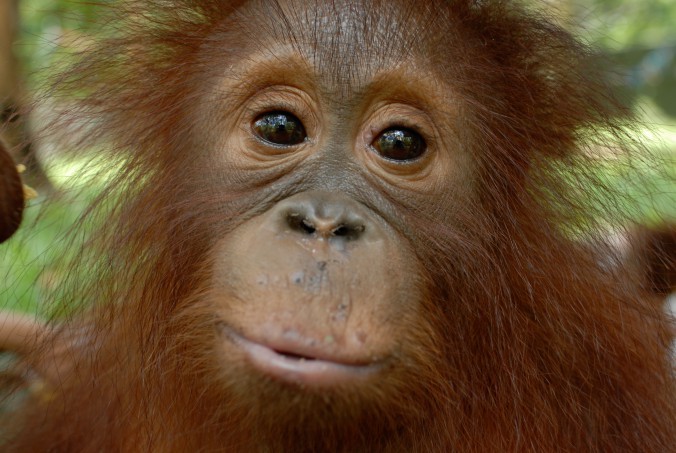The orangutan is perhaps the ultimate wildlife emblem of Southeast Asian jungles. Its compelling facial expressions and thoughtful, emotion filled eyes have instant appeal. The orangutan ranks amongst our closest relatives. Genetically they are about 97 per cent identical with us – they are intelligent, thoughtful and inventive. Now only in Borneo and Sumatra – the red apes, as they are sometimes called – possess a culture and a sense of beauty. Their name is composed of the Malay words for person (orang) and forest (hutan) that means person of the forest.
The orangutan is the world’s largest tree dwelling animal and the only great ape found outside Africa. Their forearms are 30 per cent longer than their legs and both the hands and feet are equally adept at gripping. They cannot jump like many other primates, but instead span gaps by swinging a tree back and forth until they can reach adjacent branches.
The first orangutans were carried off to Europe in 1776 as shaggy curiosities for the scientific collection of the Dutch prince, Willem V. One of the first orangutans to reach United Kingdom was a female named Jenny she was exhibited in a London zoo in 1837.
A young Charles Darwin paid her a visit in the spring of 1838. Darwin had returned from his circumnavigation in the Beagle in October 1836 and was working on his seminal work: On the origin of species by means of natural selection or preservation of favoured races in the struggle for life in 1859 and in 1868 his treatise on The Descent of Man. After he had seen Jenny, Darwin wrote in his diary:
… let man visit the ourang-outan in domestication – see his intelligence – man in his arrogance thinks himself a great works – more humble, and I believe true, to consider him created from animals.
A descendent of Jenny was presented to Queen Victoria and the young monarch observed the ape with horror stricken fascination typical of Victorians. Later she described her impression as; frightful, and painfully and disagreeably human.

Young Queen Victoria horror stricken that orang-utans were “disagreeably human”.
Orangutans have long rough hair of different shades, depending on the species and also often differing amongst members of the same genetic group – bright orange, rusty red, reddish brown and even brown black like gorillas.
Because their menu comprises several hundred kinds of fruit and because during low fruit yielding periods they feed on leaves, the orangutan appears to possess a detailed botanical understanding. Orangutans may be familiar with at least 1000 plants – edible, inedible, poisonous and beneficial. Some suggest that the botanical repertoire of orangutans could extend to 4000 plants.
Orangutans have few enemies – the Sumatra tiger, dogs and wild pigs and of course, humans. In they have been hunted and eaten probably for thousands of years. Human demand for young orangutans escalated dramatically in the 1970s when it became fashionable in social circles to show off with one of the oh-so-cute animals as a member of the household.
But young orangutans grow up and go from cute to calamitous as far as the household furniture, fittings and other inhabitants are concerned. So eventually they get either locked away in a backyard cage or sold to an orangutan butcher for meat.
However, it was the destruction of the orangutan’s habitat, particularly the explosive expansion of palm oil plantations that has led to what has been called genocide on a massive scale. Borneo really started to lose orangutan jungle habitat in a big way from the 1980s. According to reports, between 1985 and 2005 about 850,000 hectares of jungle was cleared each year. In total this amounted to about seventeen million hectares. By late 2008 about half of Borneo had been deforested.
So now the remaining living space of the approximately 50,000 orangutans still to be found in the Indonesian provinces of West, East and Central Kalimantan, as well as in Sabah and Sarawak, is extremely fragmented. Many red apes now live like castaways on an island with populations confined to these remaining ‘sanctuaries’.
Read more about orangutan’s and their need for trees in Jungle Jive: Sustaining the forests of Southeast Asia.
